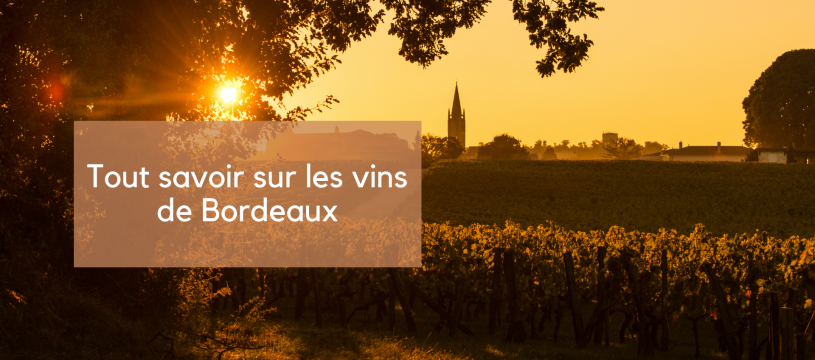
All about Bordeaux wines
Did you know that? The Bordeaux wine region is one of the most famous in the world.
Often a symbol of quality, the Bordeaux region is recognised throughout the world.
The history of the Bordeaux vineyards...
The first Bordeaux vines were born in the 1st century at the time of the Roman conquest with the importation of biturica, the ancestor of cabernet.
The Bordelais then decided to produce their own wines. This was the birth of Cabernet Franc and Cabernet Sauvignon.
The city of Bordeaux was gradually transformed into a trading city. The explosion of exported wines led to the expansion of the Bordeaux vineyards, particularly in the Graves and Médoc.
In search of quality for their wines, the Bordelais developed the use of barrels. Investments were then made in order to find new techniques that would allow producers to increase their production.
Today, the Bordeaux vineyards are characterised as a region producing quality wines with a high level of technical expertise, particularly in blending wines.
Multiple appellations divided into sub-regions
The Bordeaux wine region is divided into several sub-regions thanks to the Garonne and Dordogne rivers which flow into the Gironde estuary, naturally creating different geographical areas.
To the left of the Garonne, we have the left bank and to the right of the Dordogne: the right bank. There is also an enclave between the right and left banks called the entre-deux-mers producing an eponymous AOP.
The Bordeaux wine region has many regional appellations that can be found throughout the Bordeaux vineyards, such as AOP Bordeaux, AOP Bordeaux Supérieur and AOP Crémant de Bordeaux.
On the left bank, there are 3 wine-growing sub-regions: the Médoc, the Graves and the Sauternes.
- Within the Médoc, there are eight protected designations of origin (AOP) producing only red wines. But we have two AOPs called sub-regional which are the AOP Médoc and the AOP Haut-médoc and 6 communal AOPs: Margot, Moulis en médoc, Listrac-Médoc, Saint Julien, Pauillac and finally Saint-Estèphe.
- In the Graves, there are only 3 PDOs: Graves PDO (red and dry white wines), Graves Supérieures PDO (sweet white wines only) and Pessac-Léognan PDO which is a communal appellation (red and dry white wines).
The last sub-region of the left bank is Sauternais, it is a sub-region exploiting 3 communal AOP which produce only sweet and syrupy white wines which are: Sauternes, Barsac and Cérons.
On the right bank, the Bordeaux region has 2 sub-regions: the Libourne and the Blayais & Bourgeais.
- In the Libourne region, there are 14 AOPs, the best known being Pomerol, Lalande de Pomerol, Saint-Emilion and Saint-Emilion Grand Cru, which produce only red wines. The AOP Franc-Côtes de Bordeaux is the only appellation to produce dry and sweet white wines on the right bank.
- The Blayais & Bourgeais sub-region is located opposite the Médoc. There are several appellations such as AOP Blaye Côtes de Bordeaux or AOP Côtes de Bourg which produce red and dry white wines.
A variety of grapes for a variety of wines!
The right bank is characterised by a significant dominance of Merlot on its chalky soils, which gives the wine freshness;
The left bank is characterised by sandy soils, gravel and clay where the minerals are thicker. This mixture forms the gravel, characteristic of the châteaux and estates of the Gironde. Here, the Cabernet-Sauvignon is the king grape variety! It gives power and a good tannic structure to the wines
Unlike Burgundy, which uses only one grape variety in the composition of its wines (mainly Pinot Noir and Chardonnay), Bordeaux is renowned for its blends.
For red wines, Merlot and Cabernet Sauvignon can be blended with Cabernet Franc, Malbec, Petit Verdot or Carménère.
For white wines, the star grapes are Semillon and Sauvignon. Sémillon is particularly used for the great sweet wines of Bordeaux. Its very thin skin allows noble rot to develop easily. For dry white wines, Semillon brings richness and fatness.







